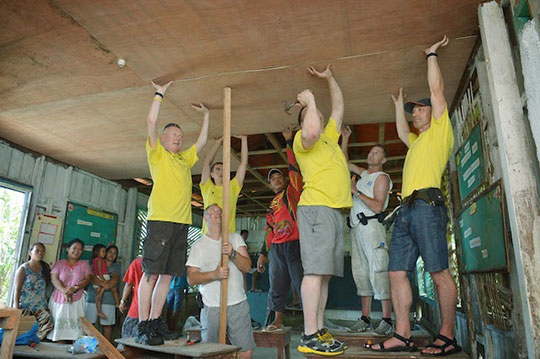































 This blog post was written by guest blogger John Baekelmans, Chief Technology Officer for Cisco's Smart+Connected Communities organization in the U.K. In the aftermath of Typhoon Haiyan, John volunteered in the Province of Samar, in the community of Daram, the Philippines, from May 1 to 17, 2014.
This blog post was written by guest blogger John Baekelmans, Chief Technology Officer for Cisco's Smart+Connected Communities organization in the U.K. In the aftermath of Typhoon Haiyan, John volunteered in the Province of Samar, in the community of Daram, the Philippines, from May 1 to 17, 2014.
I am sure most of you remember the deadly Typhoon Haiyan at the end of 2013. Haiyan, known as Typhoon Yolanda in the Philippines, was one of the strongest tropical cyclones ever recorded, which devastated portions of Southeast Asia, particularly the Philippines, on November 8, 2013. It is the deadliest Philippine typhoon on record, killing at least 6268 people in that country alone. Haiyan is also unofficially the strongest typhoon ever recorded in terms of wind speed. As of January 2014, bodies were still being found.
I know this because I was there. In addition to my day job as CTO for Cisco's Smart+Connected Communities program, I also lead Cisco's Europe, Middle East, and North Africa Disaster Incident Response Team and am a volunteer in the National Disaster Fast Response Rescue team called V-MED of Flanders, Belgium. Having been an officer in the Fire Brigade in Belgium gave me the opportunity to join this fast-response rescue team. I have been to many major disasters around the world in the past 10 years - in Myanmar, Haiti, Pakistan, Chile, and many other places. Haiti was the worst in devastation and personal impact, but Haiyan came close because of the level of poverty and the lack of primary needs.
 Haiyan is the deadliest typhoon on record in the Philippines, killing at least 6,268 people there. Photo courtesy The Telegraph
Haiyan is the deadliest typhoon on record in the Philippines, killing at least 6,268 people there. Photo courtesy The TelegraphI deployed to the Philippines with V-MED for 2 weeks this May. The V-MED team is different than most major aid organisations in that it always goes to the heart of the most affected areas, to help the most seriously affected people. Typically these are places other organisations can't or don't want to go. We went to remote islands where no other aid organisation had ever been before. Our focus was on providing primary healthcare, restoring basic drinking water needs and trying to support the educational needs.
 The author and his team leaving Tacloban for the 4-hour boat ride to the remote island community of Daram.
The author and his team leaving Tacloban for the 4-hour boat ride to the remote island community of Daram.My role in the team is to coordinate the logistics and assist with any projects we work on during our precious time during a deployment. For example, we rebuilt a primary school that was devastated after the typhoon to make sure that children could go back to school to continue their education.
 The V-MED team rebuilt a primary school that was devastated after the typhoon to make sure children could continue their education.
The V-MED team rebuilt a primary school that was devastated after the typhoon to make sure children could continue their education.Another important part of every mission is to provide basic healthcare and do minor surgeries. From the more than 50 surgeries we did in those 2 weeks, 99% of the people couldn't even afford the boat ticket to take them to the big city hospital. There is also just one doctor for more than 50,000 people in this region, so our help was more than welcome. In the 2 weeks the team was there, 6 doctors and 5 nurses did over 2500 medical consultations across 5 different remote islands.
 In 2 weeks, the V-MED team In the 2 weeks the team's 6 doctors and 5 nurses did over 2500 medical consultations and 50 surgeries.
In 2 weeks, the V-MED team In the 2 weeks the team's 6 doctors and 5 nurses did over 2500 medical consultations and 50 surgeries.Last but not in the least, the team took care of restoring the basic drinking water needs in those areas where the needs were the highest. There is no running water anywhere: people had to walk to the well or pit to wash themselves and to get drinking water for the day. On one of the islands we learned there was a dead body in the local water pit for months, but people had no choice but to continue drinking contaminated water. We took care of that immediately and we found ways to clear the pit from the contamination. In other places we bought small pumps and made a system to assemble the rainwater into tanks for distribution via taps we installed.
Giving back this way is the ultimate way of giving back to the community as you can see the direct impact of your actions. The satisfaction you get from being able to personally save lives and make an impact to so many people is the main driver for me to keep on going ... and to raise my hand to leave again when the next disaster strikes. The support I get from Cisco's management to do this without questions asked and the fact that we can take Cisco communications technology with us to enable us to communicate with our loved ones make it all so much easier.
 Tags quentes :
Corporate Social Responsibility (CSR)
Cisco CSR
volunteer
disaster relief
employee
Philippines
typhoon
Tags quentes :
Corporate Social Responsibility (CSR)
Cisco CSR
volunteer
disaster relief
employee
Philippines
typhoon